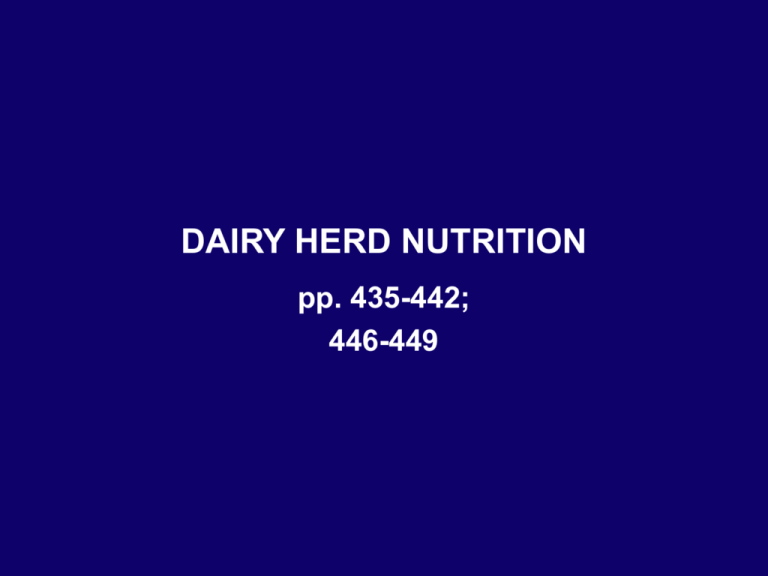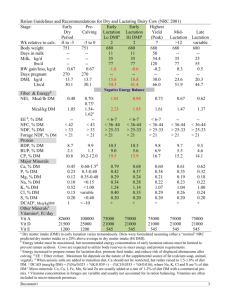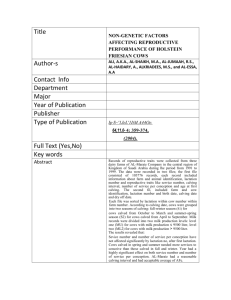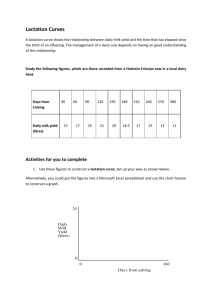Lecture 27 (Dairy Herd Nutrition)
advertisement

DAIRY HERD NUTRITION pp. 435-442; 446-449 GOALS IN FEEDING A DAIRY HERD • Maximize milk production • Maintain reproduction • Prevent metabolic diseases – Ketosis – Milk fever (parturient paresis) – Displaced abomasum • Control feed costs • Minimize nutrient excretion EARLY LACTATION THE DAIRY COW’S DILEMMA FACTORS AFFECTING DM INTAKE OF DAIRY COWS • Milk production • Week of lactation DMI, % BW – Peak feed intake follows peak milk production 4.5 4 3.5 3 2.5 2 1.5 1 0.5 0 0 10 20 30 Week of lactation 40 50 • NDF concentration • Fat concentration of diet – Feeding > 5% fat reduces DM intake • Worse problem with unsaturated fats • Diet moisture – Feeding diet > 50% moisture reduces DM intake • Improper adaptation to high grain diet reduce DM intake • Metabolic diseases (ketosis or milk fever) reduce DM intake IMPLICATIONS OF CHANGES IN FEED INTAKE OF DAIRY COWS • Increase in feed intake follows increase in milk production in early lactation • High level of feed intake increases rate of passage – A reduction in digestibility of 4% for each increase in DMI of 1x maintenance (Typically DMI will be 3x maintenace) – Reduction greater on high grain diets than high forage diets – Reduces ruminal protein degradability Energy Requirement of Dairy Cows • In lactating dairy cows, it has been shown that energy is utilized for maintenance, lactation and pregnancy with approximately equal efficiency – 60 – 70% with an average of 64.4% Lactation BW gain Energy 0 balance Maintenance Reqt 112 kcal ME Or 73.5 kcal NE/kg.75 ME intake • As a result, the energy requirements for all expressions are expressed as one term, NEl NET ENERGY REQUIREMENT FOR MAINTENANCE OF DAIRY COWS • Calculation – NEl, Mcal/day= 0.08 kg BW.75 • Factor affecting maintenance – Extra activity • Flat pasture, close • Hilly pasture, far – Temperature % increase 10 50 • Cold – Assume NEl concentration of diet reduced by 8% • Heat – Assume a 25% increase in maintenance – Pregnancy • Day 190 • Day 270 – Growth • 1st lactation • 2nd lactation % increase 60 86 % increase 20 10 NET ENERGY FOR MILK PRODUCTION BY LACTATING DAIRY COWS • NEl, Mcal/kg milk = .0929 x Fat% + .0347 x CP% + .0395 x lactose% • Example (Assume 3.4% CP and 5.8% lactose) % fat 2.5 3.0 3.5 4.0 Mcal/kg 0.59 0.64 0.68 0.74 • Simply added to maintenance NEL REQUIREMENTS OF 680 KG COW PRODUCING 10,000 KG MILK/YR FIBER REQUIREMENT OF DAIRY COWS • Adequate fiber of the appropriate length is necessary to: – Maintain milk fat percentage – Maintain rumen health (Acidosis, Parakeratosis, Laminitis, Displaced abomasum) – Maintain feed intake • Recommendations – Minimum amount of forage = 40% DM – 1989 NRC • Minimum NDF = 28% (75% from forage) • Minimum ADF = 18% – 2001 NRC NDF requirement Forage Minimum NDF, %DM 19 17 15 Diet Minimum NDF, %DM 25 29 33 • Adjustments in fiber requirement – Starch source • High moisture corn • Barley – Forage particle size 27% NDF (Minimum) 27% NDF (Minimum) • Desire length of chop of forage at ¼” 15 to 20% of particles > 1.5” – Method of feeding • Feeding separate components will increase the NDF requirement – Dietary buffers • Can lower NDF requirements • Buffers (fed at 0.5 – 1.5% of DM) – NaHCO3 – MgO – KHCO3 • Unpalatable • Will increase rumen pH, but doesn’t solve all problems associated with low fiber PROTEIN REQUIREMENTS OF LACTATING DAIRY COWS • Metabolizable protein requirement follows milk production – MP reqt, gm/d = (Maintenance + (Milk production, gm x .036))/.67 • Meeting the protein requirements of dairy cows – Increase crude protein concentration and reduce protein degradability in early lactation • No NPN use – Lower crude protein concentration and increase protein degradability in mid- and late lactation • NPN may be used in late lactation to limits – Supply enough degradable protein to meet microbial needs during dry period to 2 weeks prior to freshening • NPN may be used to limits Ca AND P REQUIREMENTS OF DAIRY COWS • Ca and P requirements follow milk production and pregnancy PHASE FEEDING OF DAIRY COWS EARLY LACTATION • First 70 days of lactation – First 3 weeks are most critical • Relationship of intake and milk production Week of peak Milk production 6-8 Feed intake 8-12 • Results – High producing dairy cows can’t meet energy requirements and fiber requirements in early lactation • Implications – Meet the cow’s fiber requirements and accept the loss in cow weight. • A dairy cow in good condition (BCS 3.5 on 5 point scale), but not overly fat, can safely lose up to 15% of her bodyweight in first 70 days. • Energy mobilized from tissue related to BCS BCS Mcal NEl 2 375 3 399 4 417 5 432 • Example – A cow at BCS 4 losing 1 BCS will produce 417 Mcal/0.74 Mcal/kg 4% FC milk = 564 kg FCM • Cows should not be at a condition score >4 coming into lactation – Will be susceptible to ketosis and displaced abomasum • Body weight lost should be replaced during late lactation – Advantages Efficiency Stage of lactation ME to tissue Tissue to milk Total Late lactation 75 82 61.5 Dry period 60 82 49.2 Diet to milk 64.4 – Additional advantages of replacing weight in late lactation » Easier to feed grain to lactating cows » Because of higher feed intake of lactating cows, easier to meet fiber requirement while feeding grain – Maximize feed intake • Don’t have cows at BCS>4 (5 point scale) • Use premium or supreme quality forage • Properly adapt cow to grain – Introduce to lactation grain mix 2 weeks before calving – Increase grain mix at 1 lb/day in early lactation to lactation diet • Delay fat supplementation until week 5 to 7 • Do not feed DDGS at greater than 20% of the DM – High fat and fiber • Do not feed corn gluten feed at greater that 25% of the DM – High fiber – Increase concentration of CP, Ca, and P in diet • Can’t mobilize these nutrients as readily as energy • Utilize sources of rumen undegradable protein and protected amino acids (lysine, methionine) – Supplement • • • • • Salt 0.5 % DM Trace mineral Vitamin A 5,500 IU/kg DM Vitamin D 1,500 IU/kg DM Vitamin E 40 IU/kg DM MID TO LATE LACTATION • Mid lactation 70 to 140 days • Late lactation 140 to 305 days • Replace body energy stores – Will cycle when positive energy balance occurs • Balance diet to meet energy and nutrient requirements • Maximum Grain = 2.5% BW • Minimum Forage = 1.5% BW • Can utilize supplemental fat to increase energy concentration Supplemental fat source Maximum fat in diet, %DM Unprotected fat (Tallow) 5 Fat in seed (Soybean, Cottonseed) 7 Ca-salt of long-chain fatty acid 7 – Problems with excess fat • Milk fat depression – Trans-10, cis-12 linoleic acid produced from hydrogenation of fatty acids in rumen of cattle fed high grain diets inhibits fatty acid in the mammary gland • Reduced feed intake • Reduced milk protein – Need to supplement RUP • Reduced digestion of Ca and Mg • Excessive fatness if BCS>3.5 – Can utilize NPN to limits • No more than 1/3 of the diet CP • No more than 1% of the diet DM – Supplement • • • • • Salt 0.5 % DM Trace mineral Vitamin A 3,700 IU/kg DM Vitamin D 1,000 IU/kg DM Vitamin E 30 IU/kg DM DRY PERIOD • 60 or 45 days to 14 days pre-calving • Goals – Maintain body condition • Prevent excessive fatness • Feed a high forage diet – Can use some lower quality for to dilute energy • May have to limit feed – Particularly corn silage • Consequence of excessive fatness is ketosis • Ketosis-fatty acid liver – In early lactation, energy must be mobilized from tissue reserves Excessive use of body fat Lack of OAA Lack of carnitine Lack of niacin Overcomes limit of triglyceride to be: 1. transported from liver as VLDL 2. oxidized in TCA cycle in liver Fat accumulates in hepatocytes (Fatty liver) Acetyl-CoA Acetoacetate B-OH-Butyrate Impairs feed intake Reduced milk production Impairs gluconeogenisis Appear in milk Increased milk fever Increased displaced abomasum Increased retained placenta Increased mastitis Reduces glucose – Ketosis prevention • Avoid excessive fatness in cows (BCS>4) • Maximize intake immediately before and after calving – Avoid abrupt change to high grain lactation diet at calving – Feed balanced ration – Use high quality forages • Drench cows with propylene glycol (1L/day) for 1 week daily before calving – Propylene glycol is metabolized to lactate that can be used for gluconeogenisis • Supplement with nicotinic acid (6 – 12 g/d) – Increases DMI – Reduces lipolysis – Recommendations » Use in ketosis prone cows » Use from 14 days prepartum to 120 days postpartum » Use palatable carrier – Prevention of milk fever • Milk fever (parturient paresis) Serum Ca, mg/100 Normal 10 Milk fever 4.6 • Occurs immediately before or after calving • Caused by failure of Ca homeostasis – Reduced calcium absorption from small intestine – Reduced mobilization of Ca from bone – Both result from alkalosis caused by a high concentration of cations relative to anions in diet • Prevention – Reduce cation-anion difference » Creates metabolic acidosis – DCAD = ([Na+] + [K+] + .15[Ca+2] + .15[Mg+2]) - ([Cl-] + .6[S-2] + .5[P-3]) Methods to decrease DCAD during dry period • Decrease concentration of cations (particularly K) in diet – K is the cation in highest concentration in dairy rations – Factors affecting dietary K levels • • • • • Legumes > Grasses Immature > Mature Leaves > Stems Heavily fertilized > Unfertilized High temperatures > Cool temperatures Dietary Ca, % .5 1.5 .5 1.5 Urine pH 1.1 5.8 5.7 Dietary K, % 2.2 3.1 8.0 8.1 7.9 8.2 Milk fever incidence 0/10 2/10 - Decrease Na concentration in diet - Decrease Ca concentration of diet??? 4/11 6/9 8/10 3/13 Method of decreasing DCAD (Continued) • Adding anions to diet – Commonly added anions • • • • • • • CaCl2 Ca propionate Ca SO4 NH4Cl (NH4)2SO4 MgCl2 MgSO4 – Unpalatable and may causes ulcers in mouth and GI tract – Monitor urine pH • Desired range 6.2 – 6.8 – CaCO3, PO4 salts and elemental S are ineffective – Recent studies increasing the anion content of forages by fertilizing with CaCl2 shows promise – Do not use on heifers • Return to positive DCAD after calving • Other considerations in dry period nutrition – Feed 12% CP • To maintain rumen microbial growth – Feed 60 to 80 gm Ca/day – Feed 30 to 40 gm P/day – Limit salt to 28 gm/day • To prevent udder edema – Vitamin A – Vitamin D – Vitamin E 5,500 IU/kg DM 1,500 IU/kg DM 40 IU/kg DM TRANSITION PERIOD • • • • 2 weeks pre-calving Feed lactation grain mix up to .5 to 1.0% BW Maintain long hay at .5 to 1.0% BW Limit corn silage to 1.0% BW





